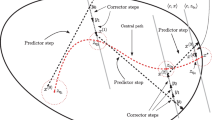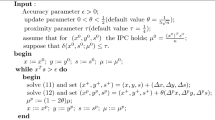Abstract
Consider linear programs in dual standard form with n constraints and m variables. When typical interior-point algorithms are used for the solution of such problems, updating the iterates, using direct methods for solving the linear systems and assuming a dense constraint matrix A, requires \(\mathcal{O}(nm^{2})\) operations per iteration. When n≫m it is often the case that at each iteration most of the constraints are not very relevant for the construction of a good update and could be ignored to achieve computational savings. This idea was considered in the 1990s by Dantzig and Ye, Tone, Kaliski and Ye, den Hertog et al. and others. More recently, Tits et al. proposed a simple “constraint-reduction” scheme and proved global and local quadratic convergence for a dual-feasible primal-dual affine-scaling method modified according to that scheme. In the present work, similar convergence results are proved for a dual-feasible constraint-reduced variant of Mehrotra’s predictor-corrector algorithm, under less restrictive nondegeneracy assumptions. These stronger results extend to primal-dual affine scaling as a limiting case. Promising numerical results are reported.
As a special case, our analysis applies to standard (unreduced) primal-dual affine scaling. While we do not prove polynomial complexity, our algorithm allows for much larger steps than in previous convergence analyses of such algorithms.
Similar content being viewed by others
References
Bertsimas, D., Tsitsiklis, J.: Introduction to Linear Optimization, Athena (1997)
Cartis, C.: Some disadvantages of a Mehrotra-type primal-dual corrector interior point algorithm for linear programming. Appl. Numer. Math. 59, 1110–1119 (2009)
Colombo, M., Gondzio, J.: Further development of multiple centrality correctors for interior point methods. Comput. Optim. Appl. 41(3), 277–305 (2008)
Dantzig, G., Ye, Y.: A build-up interior-point method for linear programming: affine scaling form. Working paper, Department of Management Science, University of Iowa, 1991
den Hertog, D., Roos, C., Terlaky, T.: Adding and deleting constraints in the path-following method for LP. In: Du, D.Z., Sun, J. (eds.) Advances in Optimization and Approximation, pp. 166–185. Kluwer Academic, Norwell (1994)
Deza, A., Nematollahi, E., Peyghami, R., Terlaky, T.: The central path visits all the vertices of the Klee-Minty cube. Optim. Methods Softw. 21(5), 851–865 (2006)
Dikin, I.I.: Iterative solution of problems of linear and quadratic programming. Dokl. Akad. Nauk SSSR 174, 747–748 (1967). English translation: Sov. Math. Dokl. 8, 674–675 (1967)
Dikin, I.I.: O skhodimosti odnogo iteratsionnogo protsessa (On the convergence of an iterative process). Upr. Sist. 12, 54–60 (1974), in Russian
Gay, D.M.: Electronic mail distribution of linear programming test problems. Math. Program. Soc. COAL Newslett. 13, 10–12 (1985). http://www-fp.mcs.anl.gov/OTC/Guide/TestProblems/LPtest/
Golub, G.H., Van Loan, C.F.: Matrix Computations. The Johns Hopkins University Press, London (1996)
Gondzio, J.: Matrix-free interior point method. Comput. Optim. Appl. (2010). doi:10.1007/s10589-010-9361-3
He, M.Y., Tits, A.L.: Infeasible constraint-reduced interior-point methods for linear optimization. Submitted for possible publication in Optim. Methods Softw., special issue in honor of Florian A. Potra’s 60-th birthday (2011). www.optimization-online.org/DB_HTML/2010/11/2822.html
Herskovits, J.N.: Développement d’une méthode numérique pour l’optimization non-linéaire. Ph.D. thesis, Université Paris IX—Dauphine, Paris, France, January 1982
Higham, N.J.: Analysis of the Cholesky decomposition of a semi-definite matrix. In: Cox, M.G., Hammarling, S.J. (eds.) Reliable Numerical Computation, pp. 161–185. Oxford University Press, London (1990)
Jansen, B., Roos, C., Terlaky, T.: A polynomial primal-dual Dikin-type algorithm for linear programming. Math. Oper. Res. 21(2), 341–353 (1996)
Kaliski, J.A., Ye, Y.: A decomposition variant of the potential reduction algorithm for linear programming. Manag. Sci. 39, 757–776 (1993)
Mangasarian, O.: A Newton method for linear programming. J. Optim. Theory Appl. 121(1), 1–18 (2004)
Mehrotra, S.: On the implementation of a primal-dual interior point method. SIAM J. Optim. 2, 575–601 (1992)
Mittelmann, H.: LP Models, Miscellaneous LP models collected by Hans D. Mittelmann: online at http://plato.asu.edu/ftp/lptestset/
Monteiro, R.D.C., Adler, I., Resende, M.G.C.: A polynomial-time primal-dual affine scaling algorithm for linear and convex quadratic programming and its power series extension. Math. Oper. Res. 15, 191–214 (1990)
O’Leary, D.P.: On bounds for scaled projections and pseudo-inverses. Linear Algebra Appl. 132, 115–117 (1990)
Panier, E.R., Tits, A.L., Herskovits, J.N.: A QP-free, globally convergent, locally superlinearly convergent algorithm for inequality constrained optimization. SIAM J. Control Optim. 26(4), 788–811 (1988)
Saigal, R.: On the primal-dual affine scaling method. Tech. report, Dept. of Industrial and Operational Engineering, The University of Michigan, 1994
Saigal, R.: A simple proof of a primal affine scaling method. Ann. Oper. Res. 62, 303–324 (1996)
Salahi, M., Terlaky, T.: Postponing the choice of the barrier parameter in Mehrotra-type predictor-corrector algorithms. Eur. J. Oper. Res. 182, 502–513 (2007)
Salahi, M., Peng, J., Terlaky, T.: On Mehrotra-type predictor-corrector algorithms. SIAM J. Optim. 18(4), 1377–1397 (2007)
Stewart, G.W.: On scaled projections and pseudo-inverses. Linear Algebra Appl. 112, 189–194 (1989)
Tits, A.L., Zhou, J.L.: A simple, quadratically convergent algorithm for linear and convex quadratic programming. In: Hager, W.W., Hearn, D.W., Pardalos, P.M. (eds.) Large Scale Optimization: State of the Art, pp. 411–427. Kluwer Academic, Norwell (1994)
Tits, A.L., Absil, P.A., Woessner, W.: Constraint reduction for linear programs with many constraints. SIAM J. Optim. 17(1), 119–146 (2006)
Tone, K.: An active-set strategy in an interior point method for linear programming. Math. Program. 59, 345–360 (1993)
Vanderbei, R.J., Lagarias, J.C.: I.I. Dikin’s convergence result for the affine-scaling algorithm. In: Lagarias, J.C., Todd, M.J. (eds.) Mathematical Developments Arising from Linear Programming: Proceedings of a Joint Summer Research Conference (Bowdoin College, Brunswick, Maine, USA), pp. 109–119. American Mathematical Society, Providence (1988)
Winternitz, L.B.: Primal-dual interior-point algorithms for linear programming problems with many inequality constraints. Ph.D. thesis, Department of Electrical and Computer Engineering, University of Maryland, College Park, MD 20742, May 2010. http://drum.lib.umd.edu/handle/1903/10400
Wright, S.J.: Primal-Dual Interior-Point Methods. SIAM, Philadelphia (1997)
Ye, Y.: An O(n 3 L) potential reduction algorithm for linear programming. Math. Program. 50(2), 239–258 (1991)
Zhang, Y., Zhang, D.: On polynomiality of the Mehrotra-type predictor-corrector interior point algorithms. Math. Program. 68, 303–31 (1995)
Zhang, D., Zhang, Y.: A Mehrotra-type predictor-corrector algorithm with polynomiality and Q-subquadratic convergence. Ann. Oper. Res. 62(1), 131–150 (1996)
Author information
Authors and Affiliations
Corresponding author
Additional information
This work was supported by NSF grant DMI0422931 and DoE grants DEFG0204ER25655 and DESC0002218. The work of the first author was supported by NASA under the Goddard Space Flight Center Study Fellowship Program. Any opinions, findings, and conclusions or recommendations expressed in this paper are those of the authors and do not necessarily reflect the views of the National Science Foundation, those of the US Department of Energy, or those of NASA.
Electronic Supplementary Material
Below is the link to the electronic supplementary material.
10589_2010_9389_MOESM1_ESM.pdf
Electronic Supplementary Material (appendix) to “A Constraint-Reduced Variant of Mehrotra’s Predictor-Corrector Algorithm” by L.B. Winternitz, S.O. Nicholls, A.L. Tits, and D.P. O’Leary. (156 KB)
Rights and permissions
About this article
Cite this article
Winternitz, L.B., Nicholls, S.O., Tits, A.L. et al. A constraint-reduced variant of Mehrotra’s predictor-corrector algorithm. Comput Optim Appl 51, 1001–1036 (2012). https://doi.org/10.1007/s10589-010-9389-4
Received:
Published:
Issue Date:
DOI: https://doi.org/10.1007/s10589-010-9389-4




